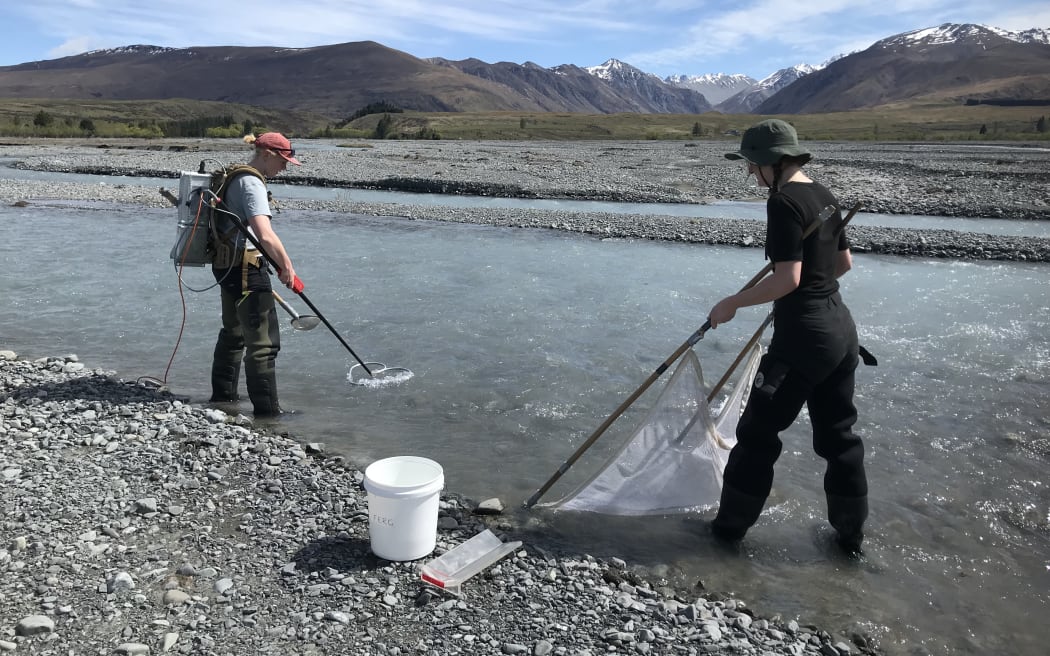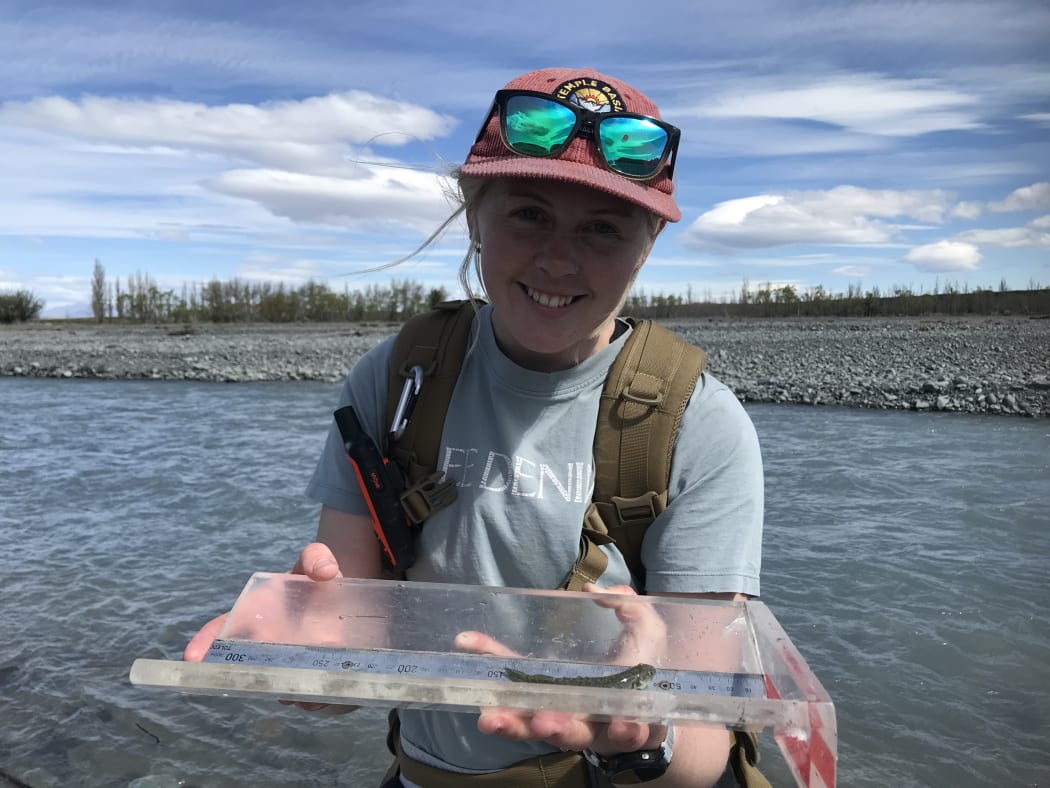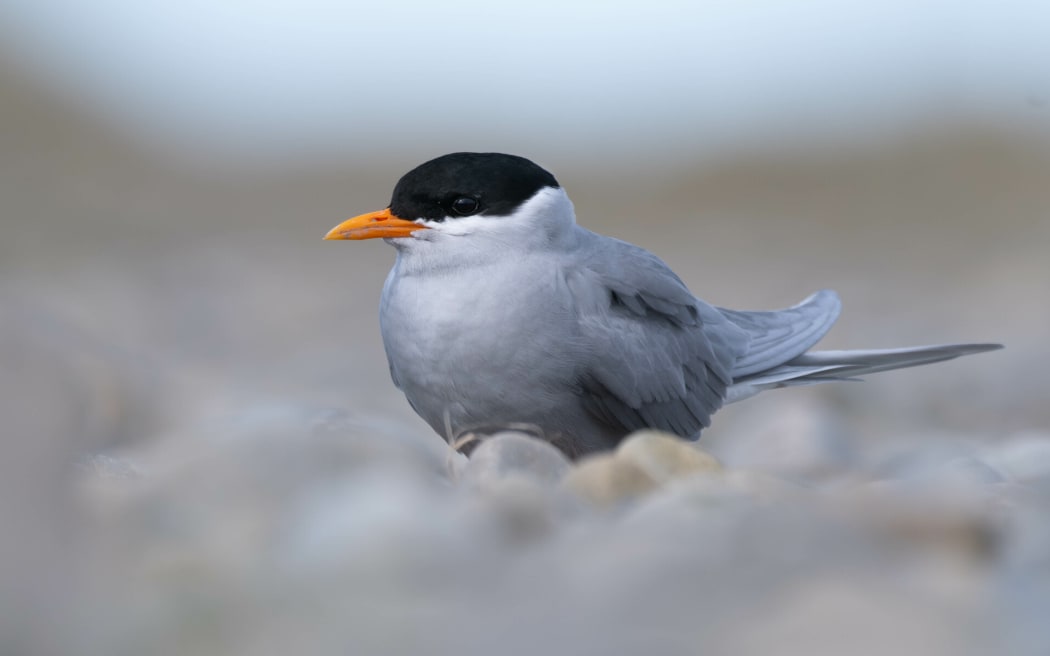It's a blue-sky spring day in the Canterbury high country. The sun beams and the wind is whipping down the wide gravel plains of the braided Cass River.
To the left is the Gamack Range. To the right, the vivid turquoise of Lake Tekapo. Black-fronted terns call out as they drift above the weaving and winding water channels, on the hunt for fish to deliver as gifts as part of their courtship.
And standing in the middle of one of the streams, water up to her knees and a heart-shaped metal wand stuck into the fast-flowing water, is University of Canterbury PhD candidate Holly Harris. She is electrofishing.

Holly Harris fishes while Zoe Hamilton holds the net. Photo: Claire Concannon / RNZ
Follow Our Changing World on Apple Podcasts, Spotify, Stitcher, iHeartRADIO, Google Podcasts, RadioPublic or wherever you listen to your podcasts.
Changing channels
Braided rivers are rare worldwide. In New Zealand they are classed as naturally rare habitats, but we are lucky in comparison to other countries. There are a few in the south of the North Island, but most can be found in Te Waipounamu.
If you've flown over the South Island you'll have seen them in all their glory - silver snaking braids of water in wide gravel floodplains making their way from the Southern Alps to the ocean.
They are complex and dynamic ecosystems. There are springs that feed side streams, and water can flow through the gravel under the surface to pop up in other places. As the seasons change, floods wash out main braids and give life to side braids. The gravel shifts and the channels can change course. It's an intricate dance that the creatures that live here have learned to adapt to.
Life and death
As in every ecosystem, in braided rivers there is an interconnected web of things eating other things. The freshwater invertebrates eat the algae that grows on settled river stones. The fish eat the invertebrates. The birds eat the fish, lizards and terrestrial invertebrates.
As part of Holly's PhD she wants to better understand the elaborate interplay between life in the river: how it is interconnected, and how it can move and adapt to the changing channels. She uses isotopic analysis of different species to investigate this.
Plus, she is taking quantitative measurements of the total river biomass across all types of channels to look at the overall stability of the system across time. To do this, she has to catch, count, measure and identify invertebrates and fish. She also takes bird counts of the endangered black-fronted terns, banded dotterels and wrybills that call the river home.

University of Canterbury PhD candidate Holly Harris measures a kōaro or climbing galaxias fish. Photo: Claire Concannon / RNZ
Threats and troubles
The Cass River still has populations of these birds and remains relatively unconstrained - unlike many of the lowland braided rivers today.
Land encroachment, gravel extraction, water removal for irrigation, and weed invasion are changing the nature of many of our braided rivers. The weeds also provide hiding spots for invasive predators, which have pushed the birds out of much of their once preferred habitat.
Holly is hoping her research will help us better understand this complex ecosystem so we can preserve what is important to us, including the endemic bird species that call it home.

Black-fronted tern tarapirohe. Photo: Ben Ackerley / iNaturalist NZ (CC BY-NC 4.0)
To learn more:
- Kōaro are one of the whitebait species that generally need to migrate to and from the ocean to complete their life cycles. But in some places their passage is being impeded by culverts and dams that we build in the way.
- We recently did an episode about the banded dotterel's endangered southern cousins - the southern New Zealand dotterel.
- Learn more about braided rivers from this 2014 episode with Alison Ballance.


